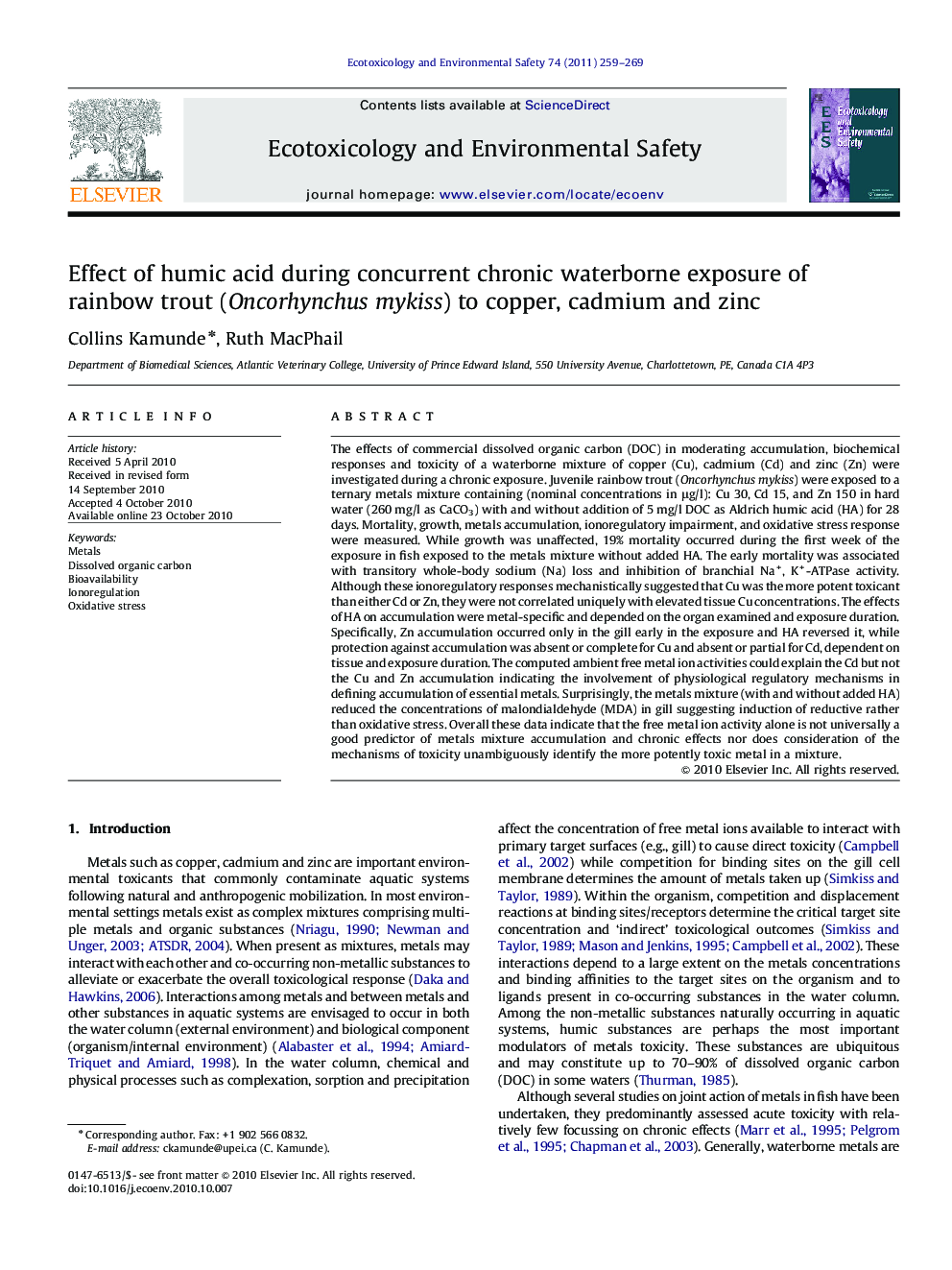| کد مقاله | کد نشریه | سال انتشار | مقاله انگلیسی | نسخه تمام متن |
|---|---|---|---|---|
| 6312470 | 1308507 | 2011 | 11 صفحه PDF | دانلود رایگان |
عنوان انگلیسی مقاله ISI
Effect of humic acid during concurrent chronic waterborne exposure of rainbow trout (Oncorhynchus mykiss) to copper, cadmium and zinc
دانلود مقاله + سفارش ترجمه
دانلود مقاله ISI انگلیسی
رایگان برای ایرانیان
کلمات کلیدی
موضوعات مرتبط
علوم زیستی و بیوفناوری
علوم محیط زیست
شیمی زیست محیطی
پیش نمایش صفحه اول مقاله

چکیده انگلیسی
The effects of commercial dissolved organic carbon (DOC) in moderating accumulation, biochemical responses and toxicity of a waterborne mixture of copper (Cu), cadmium (Cd) and zinc (Zn) were investigated during a chronic exposure. Juvenile rainbow trout (Oncorhynchus mykiss) were exposed to a ternary metals mixture containing (nominal concentrations in μg/l): Cu 30, Cd 15, and Zn 150 in hard water (260 mg/l as CaCO3) with and without addition of 5 mg/l DOC as Aldrich humic acid (HA) for 28 days. Mortality, growth, metals accumulation, ionoregulatory impairment, and oxidative stress response were measured. While growth was unaffected, 19% mortality occurred during the first week of the exposure in fish exposed to the metals mixture without added HA. The early mortality was associated with transitory whole-body sodium (Na) loss and inhibition of branchial Na+, K+-ATPase activity. Although these ionoregulatory responses mechanistically suggested that Cu was the more potent toxicant than either Cd or Zn, they were not correlated uniquely with elevated tissue Cu concentrations. The effects of HA on accumulation were metal-specific and depended on the organ examined and exposure duration. Specifically, Zn accumulation occurred only in the gill early in the exposure and HA reversed it, while protection against accumulation was absent or complete for Cu and absent or partial for Cd, dependent on tissue and exposure duration. The computed ambient free metal ion activities could explain the Cd but not the Cu and Zn accumulation indicating the involvement of physiological regulatory mechanisms in defining accumulation of essential metals. Surprisingly, the metals mixture (with and without added HA) reduced the concentrations of malondialdehyde (MDA) in gill suggesting induction of reductive rather than oxidative stress. Overall these data indicate that the free metal ion activity alone is not universally a good predictor of metals mixture accumulation and chronic effects nor does consideration of the mechanisms of toxicity unambiguously identify the more potently toxic metal in a mixture.
ناشر
Database: Elsevier - ScienceDirect (ساینس دایرکت)
Journal: Ecotoxicology and Environmental Safety - Volume 74, Issue 3, March 2011, Pages 259-269
Journal: Ecotoxicology and Environmental Safety - Volume 74, Issue 3, March 2011, Pages 259-269
نویسندگان
Collins Kamunde, Ruth MacPhail,